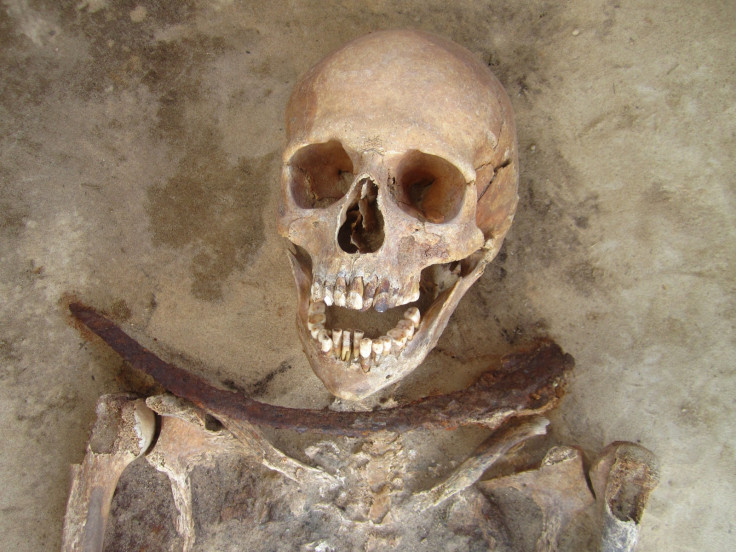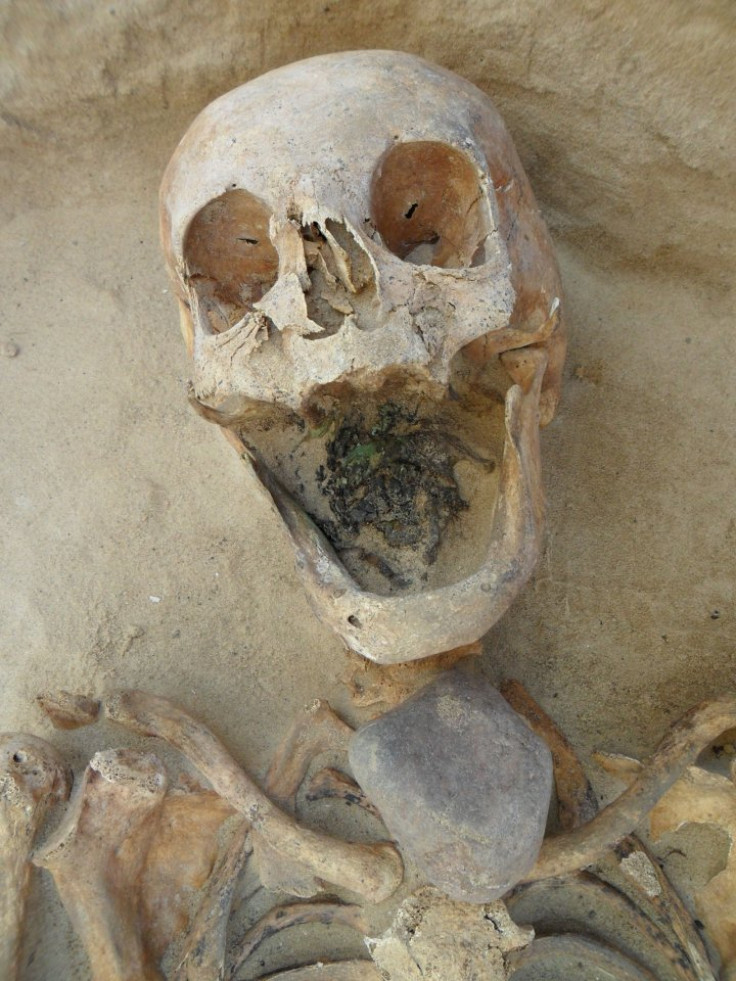How fear of the undead led to vampire burials of the sick, murdered and those 'born with a sign of the beast'

In medieval and post-medieval Europe, people believed the dead could rise from their graves so they took measures to prevent this from happening. These vampire graves have since been found in countries across Europe, with high-profile cases discovered in Poland, Bulgaria and Italy.
"Vampire" skeletons have been found with bricks lodged into their mouths, forcing open the jaw and preventing them biting future victims. Others have been found with a sickle placed over their necks – decapitating them should they try to rise, while others had their heads removed and placed between their legs.
Tracy K Betsinger, associate professor in the Department of Anthropology at SUNY College at Oneonta, has studied vampire burials in Poland, publishing research on why they were carried out – including how "vampire folklore and the deceased 'vampires'" influenced society at the time, specifically to encourage order, providing an explanation for the unknown and for economic purposes.
She told IBTimes UK that while their research focused specifically on Polish vampire burials, they could well translate to many other parts of post-medieval Europe: "Generally, a belief in vampires is based on a similar notion of evil spirits reanimating corpses and then causing problems for the living. The exact details of this belief, of course, varies over time and from culture to culture. The idea of the undead, however, and fear of the dead seems to be held cross-culturally."
In Bulgaria last year, researchers unearthed a 13th-century grave with an iron rod hammered through the skeleton's chest to stop it rising from the dead. The individual – a man in his 40s – had also had his left leg removed and placed beside the rest of the body.

The grave was discovered by Nikolai Ovcharov – an archaeologist dubbed "Bulgaria's Indiana Jones". He told the Telegraph vampire burials like this were carried out to stop "bad" people from rising from the dead and were often performed on people who had died in unusual circumstances such as suicide: "We have no doubts that once again we're seeing an anti-vampire ritual being carried out," he said at the time. "The ploughshare weighs almost two pounds and is dug into the body into a broken shoulder bone. You can clearly see how the collarbone has literally popped out."
Betsinger, was an author on a PLOS One study about a 17/18th-century burial ground in Drawsko Pomorskie in Poland, where six graves were found with sickles and rocks placed across the bodies. In the study, researchers analysed the skeletons and discovered they were from the local community. Previously, it had been thought many vampire burials were carried out on outsiders not known to the area, therefore more suspicious.
The find suggested one possible reason for the six burials was they were victims of an epidemic – something which the people at the time would have had no understanding of. At the time of their deaths there is historical evidence of a cholera epidemic in Poland, while the plague was also present. Lead author Lesley Gregoricka explained: "These diseases were things people were really afraid of – particularly cholera, which can kill you in a matter of days or hours. They didn't know that it was spread through bacteria in contaminated drinking water. They had no scientific understanding of how infectious disease was spread. Because they couldn't explain it, they contributed cholera to the supernatural – specifically to vampires."
But there were further reasons. Betsinger said: "It is important to realise that there were many potential reasons why someone could have been targeted for an anti-vampiristic burial. Being a non-local is just one of them. While this was not the apparent reason at Drawsko, it is still a possibility for other Polish sites or other sites in Europe.

"There are many alternative reasons why these people received the unusual burial treatment. Cholera outbreaks were in the area at the time, but there is no evidence that these individuals suffered from it nor that the cemetery is an epidemic one.
"There are lots of different behaviours and things that people considered risk factors for becoming a vampire once they died. These include both cultural and biological things. Suicide is definitely one of these. Murder victims and people who drowned are also considered risk factors. Lack of baptism, lack of proper burial rites, born out of wedlock, conceived during a holy period, practising witchcraft ... these are all culturally-based risk factors.
"Having a disfigurement, being born with a sign of the 'beast' (born with teeth, born with a vestigial tail, born with hair down the back), first to die in a disease outbreak... these are both biocultural risk factors. So, some of these factors are things that were undone, while others are things that were done, even though it may have not been the fault of the individual."
Gregoricka said she is currently analysing enamel samples from the six graves found in Drawsko to find out more about mobility and migration in the past: "This will provide additional lines of evidence for whether those individuals interred as potential vampires were local or non-local to the region."
Vampire burials continued through the 1800s. In the 1990s, archaeologists discovered the 19th-century grave of an adult male whose body had been staked into the ground, National Geographic reported. The skeleton, on the Greek island of Lesbos, had several eight inch iron spikes driven through his neck, pelvis and ankle.

Indeed, vampire graves have also been found in the US. Researchers in Connecticut came across an 18/19th- century grave of a man in his 50s whose head and upper leg bones had been placed in a skull and crossbone pattern. Examination revealed he had been suffering from tuberculosis, which would have caused him go pale and lose weight.
"The New England folk belief in vampires revolves around the ability of a deceased tuberculosis victim to return from the dead as a vampire and cause the 'wasting away' of the surviving relatives," archaeologists wrote in the American Journal of Physical Anthropology. "To stop the actions of the vampire, the body of the consumptive was exhumed and disrupted in various ways. Twelve historic accounts of this activity indicate that the belief was not uncommon in 19th-century New England."
And belief in vampires still persists today. A recent study by Idaho State University interviewed people who identify themselves as vampires. While it is not known how many people worldwide do see themselves as vampires, the researchers found those who do hide their identities for fear of being judged by doctors for their lifestyles.
"While the particular practice of burying people to prevent vampirism may no longer be common, beliefs in the undead/vampires have persisted, both in popular media, but also in more culturally-based beliefs," Betsinger said. "For instance, there are some people today who believe they are vampires... some are considered psychic vampires, who feed off the energy of others, while others are sanguine and believe they need to consume blood (not necessarily human) to survive.
"Popular media has certainly changed the image of the vampire. Post-medieval Polish vampires were not young, sexy, and desirable. They were scary, evil spirits that reanimated the dead and caused great harm to the living. There has been quite a shift in the perception of this very common folklore."
© Copyright IBTimes 2024. All rights reserved.






